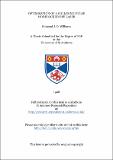Files in this item
Optimisation of a colliding-pulse modelocked dye laser
Item metadata
| dc.contributor.advisor | Sibbett, Wilson | |
| dc.contributor.author | Williams, Edmond J. O. | |
| dc.coverage.spatial | 353 p. | en_US |
| dc.date.accessioned | 2018-07-02T11:01:45Z | |
| dc.date.available | 2018-07-02T11:01:45Z | |
| dc.date.issued | 1998-05 | |
| dc.identifier.uri | https://hdl.handle.net/10023/14796 | |
| dc.description.abstract | The work presented in this thesis describes the operation, characterisation and optimisation of a colliding-pulse modelocked (CPM) dye laser. A method of pulse analysis has been developed which is capable of determining the shape and chirp of the output pulses to a first approximation. It involves an iterative pulse-fitting to intensity autocorrelation, interferometric autocorrelation and spectral measurements. The use of a four-prism sequence for intracavity dispersion compensation in a CPM dye laser resulted in pulse durations of 40-50fs. However, operating the laser close to the instability regime so as to obtain strong focusing in the absorber dye jet enabled pulse durations as short as 19fs to be obtained. A detailed empirical study of the dispersion- compensated laser, together with a theoretical and experimental chirp analysis, indicated the presence of strong phase shaping arising from a net positive self-phase modulation, which was attributed to the optical Kerr effect occurring in the absorber dye solvent. Various modes of operation were observed, including unidirectional lasing and a higher- order solitonlike regime. The results of pulse-fitting were found to yield strong evidence for pulse asymmetry, the pulse profiles corresponding closely to an asymmetric sech2 pulse function with a longer leading edge. A computer simulation of the CPM dye laser provided a comprehensive understanding of the underlying pulse shaping dynamics of this system, elucidating fully the experimental behaviours observed, as well as providing a clear strategy for further optimisation of the laser. In particular, optimal performance was found to depend on strong amplitude and strong phase shaping, minimal spectral filtering, the control of higher-order dispersion and the provision of extracavity dispersion compensation. An experimental study of Gires-Tournois interferometers (GTI's) for intracavity cubic phase compensation identified the key requirements for cubic phase control in the CPM dye laser, while highlighting the limitations of utilising conventional GTI structures. A subsequent theoretical analysis enabled a more suitable strategy to be devised. It involved optimising the cavity optics and using a prism system with variable prism spacing, alone or in tandem with specially tailored GTI structures. Implementation of these findings resulted in pulse durations of around 30-40fs and the elimination of pulse asymmetry, which was attributed to a residual positive cubic phase. However, the appearance of a distinctive modulation in the wings of the pulse provided strong evidence that the pulse durations from the CPM dye laser had become limited by the next higher-order dispersion term; quartic phase. To demonstrate the direct relevance of this work to the more recently developed solid- state laser systems, an alternative all-solid-state femtosecond laser has been described. Based around a Ti:sapphire gain medium, the design of this laser incorporates the essential optimising principles and techniques developed for the CPM dye laser. The proposed system utilises a low-loss, broadband semiconductor saturable absorber mirror to initiate self-modelocking and a hybrid prism-chirped-mirror scheme for broadband intracavity and extracavity quintic-phase-limited dispersion compensation. When fully optimised, it is predicted that this laser should yield pulse durations as short as 5fs. | en_US |
| dc.language.iso | en | en_US |
| dc.publisher | University of St Andrews | |
| dc.subject.lcc | TK7872.L3W5 | |
| dc.subject.lcsh | Lasers | |
| dc.subject.lcsh | Modelocked lasers | |
| dc.title | Optimisation of a colliding-pulse modelocked dye laser | en_US |
| dc.type | Thesis | en_US |
| dc.contributor.sponsor | SERC | en_US |
| dc.type.qualificationlevel | Doctoral | en_US |
| dc.type.qualificationname | PhD Doctor of Philosophy | en_US |
| dc.publisher.institution | The University of St Andrews | en_US |
This item appears in the following Collection(s)
Items in the St Andrews Research Repository are protected by copyright, with all rights reserved, unless otherwise indicated.

